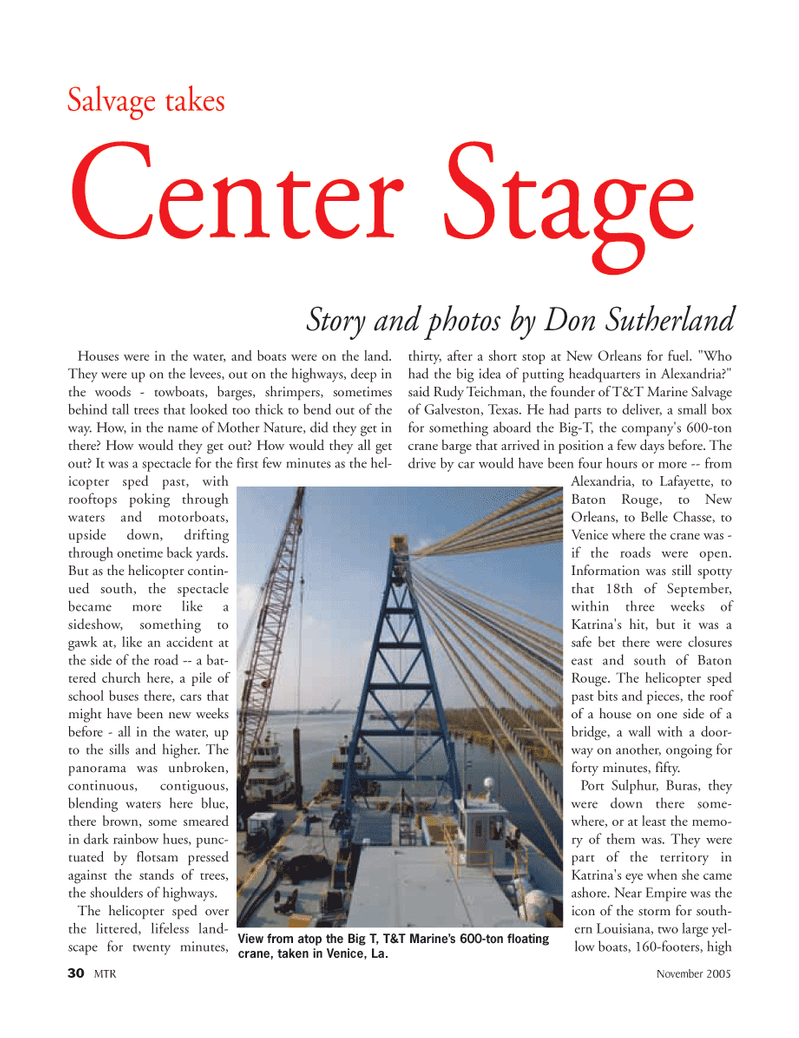
Page 30: of Marine Technology Magazine (November 2005)
Seafloor Engineering
Read this page in Pdf, Flash or Html5 edition of November 2005 Marine Technology Magazine
Houses were in the water, and boats were on the land.
They were up on the levees, out on the highways, deep in the woods - towboats, barges, shrimpers, sometimes behind tall trees that looked too thick to bend out of the way. How, in the name of Mother Nature, did they get in there? How would they get out? How would they all get out? It was a spectacle for the first few minutes as the hel- icopter sped past, with rooftops poking through waters and motorboats, upside down, drifting through onetime back yards.
But as the helicopter contin- ued south, the spectacle became more like a sideshow, something to gawk at, like an accident at the side of the road -- a bat- tered church here, a pile of school buses there, cars that might have been new weeks before - all in the water, up to the sills and higher. The panorama was unbroken, continuous, contiguous, blending waters here blue, there brown, some smeared in dark rainbow hues, punc- tuated by flotsam pressed against the stands of trees, the shoulders of highways.
The helicopter sped over the littered, lifeless land- scape for twenty minutes, thirty, after a short stop at New Orleans for fuel. "Who had the big idea of putting headquarters in Alexandria?" said Rudy Teichman, the founder of T&T Marine Salvage of Galveston, Texas. He had parts to deliver, a small box for something aboard the Big-T, the company's 600-ton crane barge that arrived in position a few days before. The drive by car would have been four hours or more -- from
Alexandria, to Lafayette, to
Baton Rouge, to New
Orleans, to Belle Chasse, to
Venice where the crane was - if the roads were open.
Information was still spotty that 18th of September, within three weeks of
Katrina's hit, but it was a safe bet there were closures east and south of Baton
Rouge. The helicopter sped past bits and pieces, the roof of a house on one side of a bridge, a wall with a door- way on another, ongoing for forty minutes, fifty.
Port Sulphur, Buras, they were down there some- where, or at least the memo- ry of them was. They were part of the territory in
Katrina's eye when she came ashore. Near Empire was the icon of the storm for south- ern Louisiana, two large yel- low boats, 160-footers, high
Salvage takes
Center Stage
Story and photos by Don Sutherland
View from atop the Big T, T&T Marine’s 600-ton floating crane, taken in Venice, La. 30 MTR November 2005
MTR#3 (17-32).qxd 11/15/2005 2:44 PM Page 30

 29
29

 31
31
